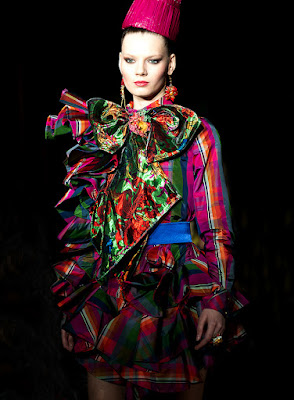 |
| La Reine Soleil, the first look in the SS25 RVDK couture collection in Paris, created from hand-woven Thai golden silk jacquard. Photograph: Jay Zoo |
While Paris basked in the luminous light of late afternoon winter sun, at the Hôtel d’Avaray, the gilded salons of the 18th-century residence, were being readied for Ronald van der Kemp to unveil his Spring/Summer 2025 couture collection. The show, titled Let the Sun Shine In, was an upbeat ode to the designer's unique approach to rethinking couture from the ground up, writes Jeanne-Marie Cilento. Photographs by Jay Zoo
 |
A sculptural gown created from Royal Thai handwoven fabrics, was last look in the show. |
 |
In brilliant hues, a ruffled silk, tartan check mini dress. |
In one of the standout opening looks, a tiered gown in gilded jacquard fanned upward like solar flares (see main picture) evoking both celestial grandeur and the layered elegance of traditional Thai dress in a contemporary way.
Van der Kemp used the silks to make subtle nods to Thai motifs, swirling lines, serpentine motifs and quilting which appeared throughout the collection, blending into a broader language of recycled opulence. What might have become pastiche in lesser hands instead offered a genuine conversation between cultures, eras, and materials.
The handmade remained at the core of every look. A checkerboard skirt emerged from a vintage Kuba wall hanging; a black coat with voluminous, wing-like sleeves was embroidered with over 3,000 beads; and a form-fitting bustier, reworked from a decommissioned boat flag, was studded with nautical chains and charms.
Long committed fully to sustainable production, RVDK garments are made in the Netherlands, often in collaboration with small ateliers and craftspeople
 |
Soigne gown of sequined leopard print with lace and leather inserts. |
Van der Kemp’s work is underpinned by rigor: behind every ruffle, twist, and beaded flourish is an intentional design. Though the collection offered cohesion in palette and material, each garment felt like an individual character, with its own history, purpose, and attitude.
The presentation itself matched the intimacy of the garments. The wood-panelled, gilded green and gold salons were the atmospheric backdrop to the show as the models moving through the audience at intimate range, allowing guests to study the embroidery, silhouette, and surface.
As a couturier, Van der Kemp has long committed fully to sustainable production, not as a marketing strategy, but as an operational principle. All garments are made in the Netherlands, often in collaboration with small ateliers and craftspeople.
The new collection once again proved that couture’s future can be created from forgotten fabrics, salvaged embellishments and fine artisan handwork
 |
This elegant pink gown was created from lingerie corsetry and finished with lace and scalloped edging. |
It’s a philosophy that doesn’t just question fashion’s excess; it actively offers alternatives. In a world where “sustainability” has become a catch-all term, Van der Kemp remains committed to the slow, sometimes inconvenient, but undeniably rewarding process of transformation. For the designer, the goal is not to make fashion that looks eco-friendly; it’s to make fashion that looks extraordinary and happens to be ethical.
His background certainly gives him the credentials for this couture creation. Before launching his own label, Van der Kemp spent more than two decades designing for houses like Celine, Guy Laroche, and Bill Blass.
The polish and discipline of those years is visible in every RVDK garment, but now it’s filtered through his own vision, one where glamour doesn’t require newness, and where imperfection is embraced rather than concealed.
For the designer, the goal is not to make couture that looks eco-friendly, it’s to make fashion that looks extraordinary and happens to be ethical
 |
Golden silk jacquard was used to create this corseted, column dress. |
Ronald van der Kemp’s creative ethos is not nostalgic, though it often draws on the visual richness of past decades. Nor is it futurist, despite its progressive ideals. It sits somewhere between, a space where history, sustainability, and couture technique intersect to offer something rare: clothes that tell stories not just of style, but of values.
With Wardrobe 21, Ronald van der Kemp once again proved that couture’s future can be created from forgotten fabrics, salvaged embellishments, and fine artisan handwork.
His collection offered the kind of glamour that is embedded in care and conviction. His silhouettes are bold, his surfaces rich, but it is the underlying philosophy that gives each piece its lasting resonance. In Ronald van der Kemp’s world, beauty is not manufactured; it is rediscovered, reframed, and reimagined. And in that quiet act of metamorphosis, couture finds both renewal and relevance.
















































